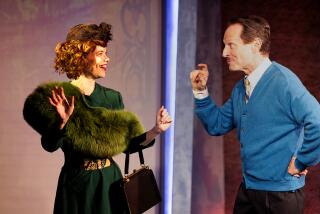A Sheltered Life in a Century of Turmoil
- Share via
THE SECRET HISTORY
OF MODERNISM
A Novel
By C.K. Stead
Harvill
230 pp., $24
Midway through C.K. Stead’s finely wrought novel, “The Secret History of Modernism,” two young devotees of literature, the narrator, Lazlo Winter, and his friend, Samantha Conlan, get to meet one of Sammy’s literary idols: novelist Christina Stead. It’s a disillusioning moment for the two young people, dismayed by Stead’s unregenerate Stalinism.
But it may well be a clarifying moment for any reader who might have been conflating two excellent, but very different writers from the Antipodes: the Australian Christina Stead (1902-1983), author of (among much else) “The Man Who Loved Children,” and the New Zealand poet, critic, editor and novelist C.K. Stead, born in 1932 and--judging from this, his latest novel--going from strength to strength.
As a critic, Stead has specialized in Modernism as practiced by Ezra Pound, William Butler Yeats and T.S. Eliot: His 1964 study, “The New Poetic,” established his reputation in this field. But those who worship at the Modernist shrine must also consider the ramifications of embracing a movement whose leading lights included anti-Semites, fascists, reactionaries and racists. This problem is at the crux of Stead’s new novel.
“The Secret History of Modernism” opens at the turn of the millennium, with Lazlo, a middle-aged novelist suffering from writer’s block, coming to a realization about his own life and the century that’s just ended:
“There was a century of history I carried within myself which in some sense was myself. Half of it ... I’d lived through with an adult consciousness. Half I’d learned from ... parents, grandparents, older friends, old soldiers; and from reading.... This narrative, or myth, or fairy-tale, this history of the century just finished, had been the story I knew best, went on learning, and had to tell myself over and over in my writing, each time with a different emphasis. It was in a way my dreamlife ... And strangely, it was the second half of the story, the half I’d been part of, that could sometimes seem less significant, less interesting, less momentous--a long aftermath rather than a denouement. It was as if the twentieth century had ended with the bullet in Hitler’s brain, the opening of the Nazi death camps, and the dropping of two atomic bombs. Since then, we’d all been in school, trying to learn the lessons, squabbling about what it all meant and where to go next ... “
A New Zealander who came of age in the 1950s, Lazlo feels twice removed--by distance and timing--from the century’s worst cataclysms. “How,” he marvels, “had I lived through two thirds of the appalling century just concluded without once dodging a bullet, hearing a bomb explode, experiencing hunger, being execrated for my skin-color or persecuted for my penile surgery?” He is struck by a sense of his own inadequacy to tell stories shaped by a history he hasn’t experienced firsthand yet cannot stop thinking about.
A chance encounter sparks memories of student days in London in the late 1950s, when the mystique of Modernism was at its height. Here, Lazlo and a band of his fellow “colonials”--brilliant, mysterious Margot, also a New Zealander; the sprightly Australian Sammy; and scholarly, spiritually questing Rajiv from India--come to seek out the elusive center of the literary world that had enchanted them from afar. Sammy is working on a project she calls “The Secret History of Modernism.” Indeed, it proves an exceedingly well-kept secret, for its contents are disclosed only toward the novel’s end.
Sammy is particularly sensitive to the fate of European Jewry because she has fallen in love with a Jewish journalist, Freddy Goldstein, one of the few members of his family to survive the Holocaust. Already married, Freddy has made it clear to Sammy that he will never abandon his wife and child, not only for the usual reasons, but also from his sense of responsibility to his people.
With a deft, sure touch, Stead interweaves three strands of narrative: the reflections and peregrinations of middle-aged Lazlo; the mildly comic adventures of young Lazlo and friends in mid-century London; and the harrowing story of the Goldsteins: Freddy’s father, who perceives the unwelcome truth and flees Europe in time, and Freddy’s uncle and family, who become trapped in the nightmare.
Meanwhile, through the device of Sammy’s secret project, Stead also poses this question: What role, if any, did the aesthetic doctrines of Modernism play in contributing to a cultural climate conducive to the merciless “hardness” exhibited by the Nazis in their pursuit of racial “purity”? To some extent, Stead seems to be engaging in a thoughtful critique of his own work as a critic who has been a consistent champion of Modernism.
Much of the poignancy of this novel resides in the contrast between the leisurely, cultivated lives of Lazlo and his friends and the brutal, unthinkable realities that the equally cultivated Goldsteins were forced to confront just one generation earlier. Like Lazlo, Stead recognizes that his ability to comprehend the century’s history is limited by the sheltered life he’s been lucky enough to lead. But in this novel, he has found a way to elucidate those aspects of the story that he knows best.
More to Read
Sign up for our Book Club newsletter
Get the latest news, events and more from the Los Angeles Times Book Club, and help us get L.A. reading and talking.
You may occasionally receive promotional content from the Los Angeles Times.







